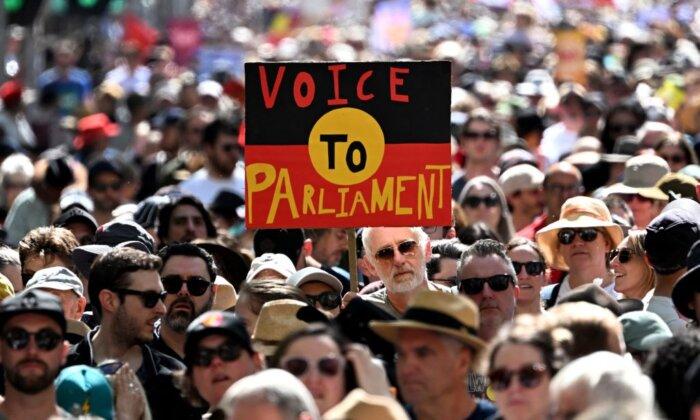Labor’s leader in the Senate, Penny Wong, has told a podcast that she believes The Voice will reappear on the political agenda within a decade.
By that time, she thinks that people will view it in the way they saw the issue of marriage equality, and wonder what all the fuss was about.
She told the Betoota Talks podcast that Prime Minister Anthony Albanese is “not a pull-the-pin kind of guy.”
“[He] thought it was the right thing to do and a lot of First Nations leaders wanted the opportunity,” she said.
“I think we’ll look back on it in ten years’ time and it’ll be a bit like marriage equality, don’t you reckon? ... Like, kids today, or even adults today, barely kind of clock that it used to be an issue. Remember how big an issue that was in the culture wars? Blimey, just endless,” she said.
The Voice proposed a constitutional amendment that would have established a permanent body of Aboriginal and Torres Strait Islander representatives to advise the Parliament on laws and policies affecting Indigenous people.
It was defeated in a public referendum with over 60 percent of Australians voting “No.”
Numerous Previous Attempts Failed
While The Voice, with its aim of rewriting the Constitution, was the most ambitious attempt to introduce Indigenous input into lawmaking, previous attempts by Australia to incorporate lesser forms of Aboriginal advisory bodies each met with failure.The first was the National Aboriginal Consultative Committee (NACC), created in February 1973 by the Whitlam government’s minister for Aboriginal affairs, Gordon Bryant, with help from well-known activist Charles Perkins.
Rather than communicating directly to Parliament, it was to advise the Department of Aboriginal Affairs (DAA) and the minister on issues of concern to Aboriginal and Torres Strait Islander people.
However, it met with strong opposition from within the DAA and saw itself as a legislative body, while the government expected its role to be purely advisory.
There were conflicts over control, funding levels, and even the name, which led to it being disbanded in 1976.
A subsequent review commissioned by the Fraser government concluded that the NACC had not functioned as a consultative committee and had not been effective in providing advice to the government or making its activities known to most Aboriginal people.
A year later, the National Aboriginal Congress (NAC) was established, and given an explicitly advisory role and a smaller budget.
However, Indigenous leaders wanted it to have a more direct role in policy creation and used the NAC’s official status to campaign internationally and in local media for a greater direct say.
ATSIC Plagued by Corruption Allegations
Five years later, the Aboriginal and Torres Strait Islander Commission (ATSIC) was established. It was an elected body responsible for administering Indigenous programs and service delivery.However, it was plagued by issues such as low voter turnout, allegations of corruption, and a lack of government support.
A 2003 review recommended various changes, but the Howard government decided not to proceed with the recommendations and instead abolished ATSIC in 2005 with the support of the Labor Party under Mark Latham.
However, the government had already begun to establish the National Indigenous Council (NIC), which the ATSIC inquiry recommended be “a temporary body, to exist only until a proper national, elected representative body is in place.”
It lasted two years, until 2008, and was disbanded after a Select Committee inquiry concluded that it had no support, with only the government viewing it as legitimate.
Another attempt was made in 2009, developed by the Australian Human Rights Commission at the request of the Rudd Labor government, called the National Congress of Australia’s First Peoples.
However, fewer than 10,000 Indigenous people signed up as members to elect congress delegates, and the Abbott government cut its funding in 2013. It subsequently went into voluntary administration in June 2019 and ceased completely in October of that year.
Having abandoned the National Congress, the Abbott government took a slightly different approach and set up the Prime Minister’s Indigenous Advisory Council in September 2013. It consisted of 12 members, both Indigenous and non-Indigenous, and met three times a year.
When the Liberal Party replaced Abbott with Malcolm Turnbull, the new prime minister restructured the body, reducing its size to six members, abolishing the role of chair, and creating two co-chairs.
It was never formally abolished, but held its last meeting in early 2019.






